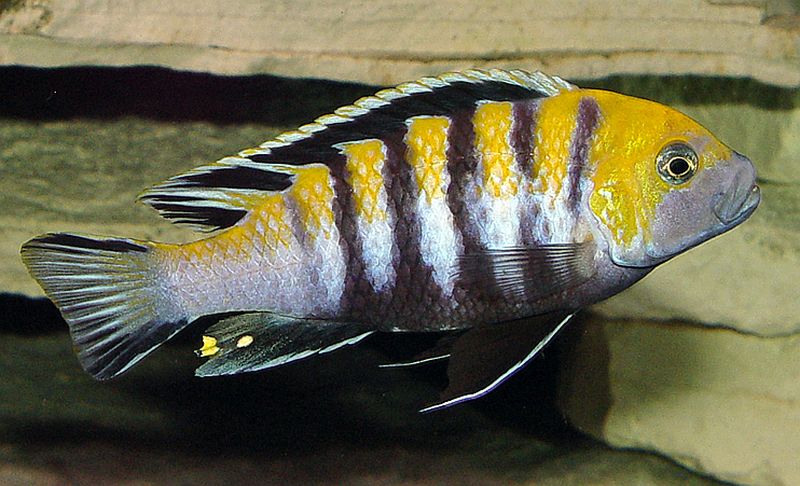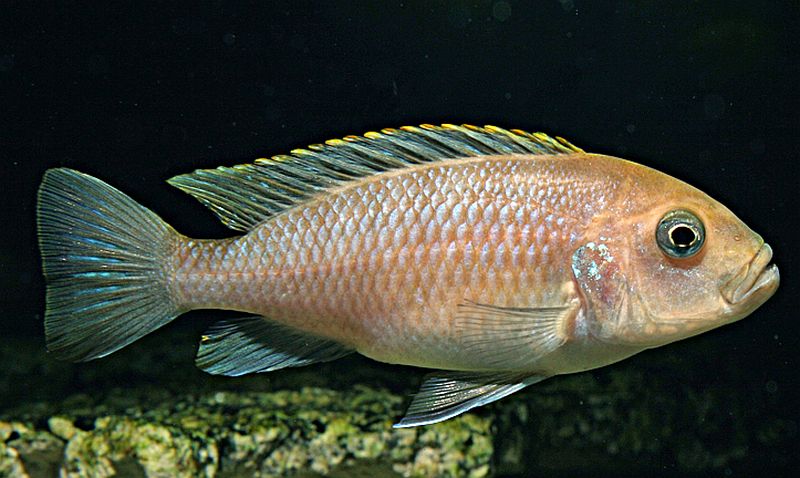The Afra Edwardi, Cynotilapia zebroides (Cobue) is a dwarf Lake Malawi Mbuna cichlid found in Cobwe’, Mozambique. In their Natural Habitat, Cynotilapia zebroides are found in the deeper to intermediate rocky regions and open waters of the lake. They are also known by tropical fish keeping enthusiasts as Orangeback Mozambique, Edwardi afra, Orange Backs, or Microchromis zebroids “Cobue”.
Until recently, Cynotilapia zebroids “Cobue” was known as Cynotilapia afra “Cobue”; sometimes spelled cobwe’.
Except for their diminutive size and the fact that they have unicuspid teeth instead of bicuspids; Afra are very similar to the “zebra types”. Because of their dental work, the Afra is also known as the dogtooth cichlid.
Depending on where they are collected from, Afra cichlids from different locations can look very different from each other.
The male Afra Edwardi (Cynotilapia zebroides – “Cobue”) is quite colorful. Juvenile males have yellow orange stripes over a blueish to purplish body. As they reach adulthood, the backs of the males become a bright yellow, with a yellow/orange forehead that gradually blends into white or purple/blue beneath. Five or more vertical black stripes cover the body through the dorsal fin. The pectoral and anal fins become black rimmed with yellow or white and their caudal fins have are blueish to translucent, edged with black on top and below. Males also have egg like spots on their anal fins.
Juvenile female Afra Edwardi tend to be less colorful. They have a light brown body with a yellow edge on their dorsal fin. As the reach adulthood, the body color deepens and develops a blueish tinge with faint vertical stripes.
Keeping and raising Orange Backs is not difficult. Cynotilapia zebroides – “Cobue” are best kept in a 55 gallon or larger aquarium with a dark sandy or fine gravel substrate and plenty of holey rock for shelter and hiding places. These cichlids are cave dwellers that spend a great deal of their time on or close to the bottom. Afra Edwardi are non aggressive towards other cichlids and mix well with most other mbuna that are not of the same color.
They can be kept with Haplochromis, some of the Lake Victorian cichlids, and with some Peacocks as long as they have plenty of rock caves in their tank. They should not be housed with other Mbuna of the same or similar color and are only aggressive towards they own kind when spawning or staking out their territory. Like most fish, they benefit from weekly water changes equal to 15% of the tank volume.
Afra Edwardi are maternal mouthbrooders that breed in mixed sex groups when they reach 2″ to 2 1/2″ in size. In an aquarium environment they can be bred in a tank as small as 15 to 20 gallons, but larger tanks give better results. For the best results, keep two males in a tank with 4 to 6 females. Although they are easy to breed, males can sometimes be tough on the females.
The dominant male will be more colorful than the other males and when ready to breed will flutter and shake around the female to entice her to spawn. During this period, the males colors become vibrant and his fins become more flared. When ready, the female will deposit her eggs in various locations on the rocks in the tank. The fertilized egg is immediately scooped up by the female and held in her mouth. This process is continued until spawning is completed, at which time the male seems to lose interest and goes about his business.
The female holds the eggs in her mouth for approximately 3 weeks and during this time does not eat. After the eggs have hatched, most breeders strip the fry from the mother to raise them in a separate rearing tank. The fry are colored light gray and can be fed crushed flake food and live or freeze dried daphnia.
As adults, they should be fed a varied diet of live, frozen, or freeze dried daphnia, krill, brine shrimp, Spirulina
Flakes, New Life Spectrum pellets, or other small Cichlid micro pellets
.
Minimum Tank Size: 55 gallons
Care Level: Moderately Easy
Temperament: Semi aggressive
Aquarium Hardiness: Moderately hardy
Water Conditions: 75-81° F, pH 7.8-9.0, KH 15-25
Max. Size: Male 3 1/2″, Females 3″
Color Form: Yellow, Blue
Diet: Omnivore
Compatibility: Relatively calm mbuna cichlid
Origin: Cobwe’, Mozambique; Lake Malawi, Africa
Family: Cichlidae
Lifespan: 5-10 years
Aquarist Experience Level: Intermediate







